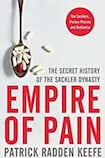
As the United States reels from the coronavirus pandemic which has claimed close to 600,000 lives, another epidemic has been quietly raging across the country.
Last year alone, more than 80,000 Americans died from overdoses, continuing a trend stretching back to the early 2000s. According to many experts, America’s opioid epidemic has been the biggest public health crisis facing the country in decades. Remarkably, the majority of opioid deaths are linked to legally-available drugs prescribed by doctors.
In his new book, Patrick Radden Keefe examines the central role played by one family in America’s opioid crisis. A staff writer at the New Yorker, Radden Keefe is perhaps best known for his critically-acclaimed book about the Troubles, Say Nothing. In Empire of Pain he turns his investigative and narrative skills to the Sacklers, an aloof but insidiously influential New York family, whose colossal fortune has derived in part from the development of a highly addictive opioid called OxyContin.
Though the core of the book is an exposé of the role of the Sacklers’ businesses in fuelling the opioid pandemic in the US, Empire of Pain opens in the colourful and salubrious setting of New York in the 1920s. The author traces the life and times of Arthur Sackler and his two brothers who together built a pharmaceutical empire. Arthur, a doctor, businessman and publisher, is the patriarch of the family, whose voracious ambition first generates the family’s wealth. His foray into the business of advertising proves to be a smart move. In the early 1960s he begins marketing two tranquilizers – Librium and Valium – cannily negotiating a deal that saw him generate profit in proportion to sales, while ignoring concerns about the drugs’ addictive properties. As Radden Keefe puts it: “The original House of Sackler was built on valium.”
This period saw the genesis of a sentiment that was to become the Sacklers’ mantra in subsequent decades as they blithely abdicated any responsibility for opioid misuse – it was not the pills that were causing the addiction, it was the addictive personalities of the patients that used them.
During this time, Arthur moved into philanthropy, propelled by an almost maniacal obsession with east Asian art collecting. Deals with various museums and institutes followed, including an arrangement which saw the entire Temple of Dendur shipped from Egypt and re-assembled in a specially named “Sackler Wing” at the Metropolitan Museum of Art.
Highly addictive
As the Sackler family name became increasingly associated with the world of art and philanthropy in the US and Europe, there were Sackler wings and Sackler scholarships aplenty. But the Sacklers skilfully managed to keep their names away from the actual businesses that were generating their enormous wealth, such as the Connecticut-based Perdue Pharma.
By the time Arthur died in 1987, his relationship with his two younger siblings Mortimer and Raymond had soured. But the family business was moving into a new phase of growth. Perdue’s development of OxyContin was a game-changer. Much as valium had been the cash-cow for Arthur Sackler, the company threw its resources behind promoting its new product. OxyContin was the painkiller “to start with and to stay with”, Perdue’s sales reps intoned, a catchphrase that was to become brutally fitting, when millions of people became hooked.
The drug was marketed as a safer, less extreme alternative to morphine, its special coating allowing for the drug inside to be released gradually. But it soon emerged that patients were finding ways to remove the coating and ingest the drug directly. Many people, who had been prescribed the drug for conditions like chronic back pain, for example, became addicted, finding that the relief promised by the pill evaporated long before the 12-hour period recommended. Doctors prescribed more and more OxyContin in greater dosages. Some patients soon graduated to heroin – a closely-related and sometimes cheaper alternative.
Pop-up protests
Radden Keefe offers a forensic account of the Sackler family’s direct involvement in the development and promotion of the drug. Among his sources are thousands of documents released during discovery in a 2007 federal case when Perdue executives admitted guilt and agreed to pay a fine. The author also speaks to former employees, sales reps and reformed addicts, including the celebrated photographer Nan Goldin. Her pop-up protests at museums across the globe helped goad institutions to eventually stop taking money from the Sackler family.
Radden Keefe is particularly damning of the current generation of Sacklers – his portrait of fashionista Joss Sackler who Instagrams her life and fashion brand while dismissing the source of her husband’s wealth as an irrelevancy is deliciously arch. But while the book is a damning portrait of the Sacklers, Empire of Pain also raises questions about the other bad actors that helped stoke America’s opioid crisis. As the US comes to terms with the devastating pandemic, an investigation into the US pharmaceutical regulators and the thousands of doctors who prescribed drugs like OxyContin should be next.
Suzanne Lynch is Washington Correspondent for The Irish Times











